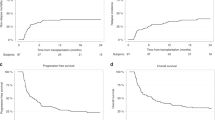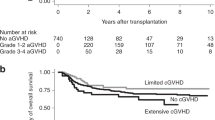Abstract
Delayed hematologic recovery is common after unrelated donor umbilical cord blood transplants (UCBT). Clinically it is important to quickly differentiate slow engraftment from graft failure (GF). We report the engraftment data on 110 pediatric UCBT recipients. By day 28, 71 patients achieved an ANC >0.5 × 109 per liter, and 6 others died early without recovery. Of the remaining 33 patients who were still neutropenic, 20 eventually attained donor myeloid recovery, 3 died of transplant-related complications or recurrent leukemia and 10 survived without donor-derived hematopoiesis. These patients received a second UCBT 33–95 days after the first transplant, after additional immunosuppression. One patient died early, the remaining nine patients were engrafted; eight demonstrated complete, and one mixed, donor chimerism (with subsequent graft loss). Acute GVHD developed in three, and chronic GVHD in six of the eight engrafted patients. Two patients developed EBV-lymphoproliferative disorder. Infections, especially viral, were common and protracted. Six of 10 patients are alive, 165–1375 (median 1147) days after second UCBT. Chimerism studies correlated with subsequent engraftment course. Any result showing <5% donor cells was associated with irreversible graft loss. In conclusion, early second UCBT after primary GF is a feasible treatment option. Chronic GVHD and viral reactivation are common post transplant.
This is a preview of subscription content, access via your institution
Access options
Subscribe to this journal
Receive 12 print issues and online access
$259.00 per year
only $21.58 per issue
Buy this article
- Purchase on Springer Link
- Instant access to full article PDF
Prices may be subject to local taxes which are calculated during checkout


Similar content being viewed by others
References
Rubinstein P, Carrier C . Placental blood for bone marrow replacement: the New York Blood Center's program and clinical results. Baillieres Clin Haematol 2000; 13: 565–584.
Wagner JE, Rosenthal J, Sweetman R, Shu XO, Davies SM, Ramsay NKC et al. Successful transplantation of HLA-matched and HLA-mismatched umbilical cord blood from unrelated donors: analysis of engraftment and acute graft-versus-host disease. Blood 1996; 88: 795–802.
Thompson BG, Robertson KA, Gowan D, Heilman D, Broxmeyer HE, Emanuel D et al. Analysis of engraftment, graft-versus-host disease, and immune recovery following unrelated donor cord blood transplantation. Blood 2000; 96: 2703–2711.
Kernan NA, Carter SL, Wagner JE, Baxter-Lowe L, Wall D, Kapoor N et al. Umbilical cord blood transplantation in pediatric patients: results of the prospective, multi-institutional cord blood transplantation study (COBLT). Biol Blood Marrow Transplant 2006; 12 (Suppl 1): 14 (abst 33).
Michel G, Rocha V, Chevret S, Arcese W, Chan KW, Filipovich A et al. Unrelated donor cord blood transplantation for childhood acute myeloid leukemia: a Eurocord Group analysis. Blood 2003; 102: 4290–4297.
Barker JN, Krepski TP, DeFor TE, Davies SM, Wagner JE, Weisdorf DJ . Searching for unrelated donor hematopoietic stem cells: availability and speed of umbilical cord blood versus bone marrow. Biol Blood Marrow Transplant 2002; 8: 257–260.
Ohwada C, Nakaseko C, Ozawa S, Takeuchi M, Shono K, Koizumi M et al. Second cord blood transplantation with reduced-intensity conditioning for graft failure after first CBT for AML. Bone Marrow Transplant 2004; 34: 999–1000.
Fernandes J, Rocha V, Robin M, Peffault de Latour R, Traineau R, Devergie A et al. Second transplant with two unrelated cord blood units for early graft failure after haematopoietic stem cell transplantation. Br J Haematol 2007; 137: 248–251.
Mizutani E, Narimatsu H, Murata M, Tomita A, Kiyoi H, Naoe T . Successful second cord blood transplantation using fludarabine and cyclophosphamide as a preparative regimen for graft rejection following reduced-intensity cord blood transplantation. Bone Marrow Transplant 2007; 40: 85–87. April 23 (e-pub ahead of print).
Narimatsu H, Kami M, Miyakoshi S, Murashige N, Yuji K, Hamaki T et al. Graft failure following reduced-intensity cord blood transplantation for adult patients. Br J Haematol 2005; 132: 36–41.
Shimada K, Narimatsu H, Morishita Y, Kohno A, Saito S, Kato Y . Severe regimen-related toxicity of second transplantation for graft failure following reduced-intensity cord blood transplantation in an adult patient. Bone Marrow Transplant 2006; 37: 787–788.
Davies S, Weisdorf DJ, Haake RJ, Kersey JH, McGlave PB, Ramsey NKC et al. Second infusion of bone marrow for treatment of graft failure after allogeneic bone marrow transplantation. Bone Marrow Transplant 1994; 14: 73–77.
Guardiola P, Kuentz M, Garban F, Blaise D, Reiffers J, Attal M et al. Second early allogeneic stem cell transplantation for graft failure in acute leukemia, chronic myeloid leukemia and aplastic anemia. Br J Haematol 2000; 111: 292–302.
Remberger M, Ringden O, Ljungman P, Hagglund H, Winiarski J, Lonnqvist B et al. Booster marrow or blood cells for graft failure after allogeneic bone marrow transplantation. Bone Marrow Transplant 1998; 22: 73–78.
Grandage VL, Cornish JM, Pamphilon DH, Potter MN, Steward CG, Oakhill A et al. Second allogeneic bone marrow transplants from unrelated donors for graft failure following initial unrelated donor bone marrow transplantation. Bone Marrow Transplant 1998; 21: 687–690.
Bolger GB, Sullivan KM, Storb R, Witherspoon RP, Weiden PL, Stewart P et al. Second marrow infusion for poor graft function after allogeneic marrow transplantation. Bone Marrow Transplant 1986; 1: 21–30.
Wolff SN . Second hematopoietic stem cell transplantation for the treatment of graft failure, graft rejection or relapse after allogeneic transplantation. Bone Marrow Transplant 2002; 29: 545–552.
Barker JN, Weisdorf DJ, DeFor TE, Blazer BR, Miller JS, Wagner JE . Rapid and complete donor chimerism in adult recipients of unrelated donor umbilical cord blood transplantation after reduced-intensity conditioning. Blood 2003; 102: 1915–1919.
Barker JN, Hough RE, van Burik JA, DeFor TE, MacMillan ML, O'Brien MR et al. Serious infections after unrelated donor transplantation in 136 children: impact of stem cell source. Biol Blood Marrow Transplant 2005; 11: 362–370.
Sashihara J, Tanaka-Taya K, Tanaka S, Amo K, Miyagawa H, Hosoi G et al. High incidence of human herpesvirus 6 infection with a high viral load in cord blood stem cell transplant recipients. Blood 2002; 100: 2005–2011.
Parody R, Martino R, Rovira M, Vazquez L, Vazquez MJ, de la Camara R et al. Severe infections after unrelated donor allogeneic hematopoietic stem cell transplantation in adults: comparison of cord blood transplantation with peripheral blood and marrow transplantation. Biol Blood Marrow Transplant 2006; 12: 734–748.
Barker JN, Martin PL, Coad JE, DeFor TE, Trigg ME, Kurtzberg J et al. Low incidence of Epstein-Barr virus-associated posttransplant lymphoproliferative disorders in 272 unrelated-donor umbilical cord blood transplant recipients. Biol Blood Marrow Transplant 2001; 7: 395–399.
Brunstein CG, Weisdorf DJ, DeFor T, Barker JN, Tolar J, van Burik JA et al. Marked increased risk of Epstein-Barr virus-related complications with the addition of antithymocyte globulin to a nonmyeloablative conditioning prior to unrelated umbilical cord blood transplantation. Blood 2006; 108: 2874–2880.
Zecca M, Prete A, Rondelli R, Lanino E, Balduzzi A, Messina C et al. Chronic graft-versus-host disease in children: incidence, risk factors, and impact on outcome. Blood 2002; 100: 1192–1200.
Scharf SJ, Smith AG, Hansen JA, McFarland C, Erlich HA . Quantitative determination of bone marrow transplant engraftment using fluorescent polymerase chain reaction primers for human identity markers. Blood 1995; 85: 1954–1963.
Antin JH, Childs R, Filipovich AH, Giralt S, MacKinnon S, Spitzer T et al. . Biol Blood Marrow Transplant 2001; 7: 473–485.
Bader P, Holle W, Klingebiel T, Handgretinger R, Benda N, Schlegel PG et al. Mixed hematopoietic chimerism after allogeneic bone marrow transplantation: the impact of quantitative PCR analysis for prediction of relapse and graft rejection in children. Bone Marrow Transplant 1997; 19: 697–702.
Cimino G, Rapanotti MC, Elia L, Lori AP, Gugliemi C, Screnci M et al. A prospective molecular study of chimerism in patients with haematological malignancies receiving unrelated cord blood or bone marrow transplants: detection of mixed chimerism predicts graft failure with or without early autologous reconstitution in cord blood recipients. Br J Haematol 1999; 104: 770–777.
Hill RS, Petersen FB, Storb R, Appelbaum FR, Doney K, Dahlberg S et al. Mixed hematologic chimerism after allogeneic marrow transplantation for severe aplastic anemia is associated with a higher incidence of graft rejection and a lessened incidence of acute graft-versus-host disease. Blood 1986; 67: 811–816.
Author information
Authors and Affiliations
Corresponding author
Rights and permissions
About this article
Cite this article
Chan, K., Grimley, M., Taylor, C. et al. Early identification and management of graft failure after unrelated cord blood transplantation. Bone Marrow Transplant 42, 35–41 (2008). https://doi.org/10.1038/bmt.2008.40
Received:
Revised:
Accepted:
Published:
Issue Date:
DOI: https://doi.org/10.1038/bmt.2008.40
Keywords
This article is cited by
-
Increase of bone marrow macrophages and CD8+ T lymphocytes predict graft failure after allogeneic bone marrow or cord blood transplantation
Bone Marrow Transplantation (2017)
-
Successful early unmanipulated haploidentical transplantation with reduced-intensity conditioning for primary graft failure after cord blood transplantation in hematologic malignancy patients
Bone Marrow Transplantation (2015)
-
Successful rescue of early graft failure in pediatric patients using T-cell-depleted haploidentical hematopoietic SCT
Bone Marrow Transplantation (2014)
-
Early peripheral blood and T-cell chimerism dynamics after umbilical cord blood transplantation supported with haploidentical cells
Bone Marrow Transplantation (2014)
-
Are backup BM harvests worthwhile in unrelated donor allogeneic transplants?
Bone Marrow Transplantation (2010)



